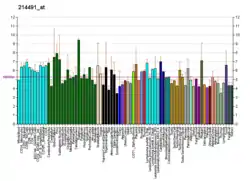Somatostatin receptor 3
Shekel Somatostatin receptor type 3 is a protein that in humans is encoded by the SSTR3 gene.[5][6]
Function
Somatostatin acts at many sites to inhibit the release of many hormones and other secretory proteins. The biological effects of somatostatin are probably mediated by a family of G protein-coupled receptors that are expressed in a tissue-specific manner. SSTR3 is a member of the superfamily of receptors having seven transmembrane segments and is expressed in highest levels in brain and pancreatic islets. SSTR3 is functionally coupled to adenylyl cyclase.[6]
See also
References
- GRCh38: Ensembl release 89: ENSG00000278195 - Ensembl, May 2017
- GRCm38: Ensembl release 89: ENSMUSG00000044933 - Ensembl, May 2017
- "Human PubMed Reference:". National Center for Biotechnology Information, U.S. National Library of Medicine.
- "Mouse PubMed Reference:". National Center for Biotechnology Information, U.S. National Library of Medicine.
- Yamada Y, Stoffel M, Espinosa R, Xiang KS, Seino M, Seino S, Le Beau MM, Bell GI (February 1993). "Human somatostatin receptor genes: localization to human chromosomes 14, 17, and 22 and identification of simple tandem repeat polymorphisms". Genomics. 15 (2): 449–52. doi:10.1006/geno.1993.1088. PMID 8449518.
- "Entrez Gene: SSTR3 somatostatin receptor 3".
Further reading
- Yamada Y, Reisine T, Law SF, Ihara Y, Kubota A, Kagimoto S, Seino M, Seino Y, Bell GI, Seino S (December 1992). "Somatostatin receptors, an expanding gene family: cloning and functional characterization of human SSTR3, a protein coupled to adenylyl cyclase". Molecular Endocrinology. 6 (12): 2136–42. doi:10.1210/me.6.12.2136. PMID 1337145.
- Yamada Y, Post SR, Wang K, Tager HS, Bell GI, Seino S (January 1992). "Cloning and functional characterization of a family of human and mouse somatostatin receptors expressed in brain, gastrointestinal tract, and kidney". Proceedings of the National Academy of Sciences of the United States of America. 89 (1): 251–5. doi:10.1073/pnas.89.1.251. PMC 48214. PMID 1346068.
- Corness JD, Demchyshyn LL, Seeman P, Van Tol HH, Srikant CB, Kent G, Patel YC, Niznik HB (April 1993). "A human somatostatin receptor (SSTR3), located on chromosome 22, displays preferential affinity for somatostatin-14 like peptides". FEBS Letters. 321 (2–3): 279–84. doi:10.1016/0014-5793(93)80124-D. PMID 8097479.
- Law SF, Zaina S, Sweet R, Yasuda K, Bell GI, Stadel J, Reisine T (April 1994). "Gi alpha 1 selectively couples somatostatin receptor subtype 3 to adenylyl cyclase: identification of the functional domains of this alpha subunit necessary for mediating the inhibition by somatostatin of cAMP formation". Molecular Pharmacology. 45 (4): 587–90. PMID 8183236.
- Kaupmann K, Bruns C, Hoyer D, Seuwen K, Lübbert H (September 1993). "Distribution and second messenger coupling of four somatostatin receptor subtypes expressed in brain". FEBS Letters. 331 (1–2): 53–9. doi:10.1016/0014-5793(93)80296-7. PMID 8405411.
- Sharma K, Patel YC, Srikant CB (December 1996). "Subtype-selective induction of wild-type p53 and apoptosis, but not cell cycle arrest, by human somatostatin receptor 3". Molecular Endocrinology. 10 (12): 1688–96. doi:10.1210/me.10.12.1688. PMID 8961277.
- Fukusumi S, Kitada C, Takekawa S, Kizawa H, Sakamoto J, Miyamoto M, Hinuma S, Kitano K, Fujino M (March 1997). "Identification and characterization of a novel human cortistatin-like peptide". Biochemical and Biophysical Research Communications. 232 (1): 157–63. doi:10.1006/bbrc.1997.6252. PMID 9125122.
- Ain KB, Taylor KD, Tofiq S, Venkataraman G (June 1997). "Somatostatin receptor subtype expression in human thyroid and thyroid carcinoma cell lines". The Journal of Clinical Endocrinology and Metabolism. 82 (6): 1857–62. doi:10.1210/jc.82.6.1857. PMID 9177396.
- de Lecea L, Ruiz-Lozano P, Danielson PE, Peelle-Kirley J, Foye PE, Frankel WN, Sutcliffe JG (June 1997). "Cloning, mRNA expression, and chromosomal mapping of mouse and human preprocortistatin". Genomics. 42 (3): 499–506. doi:10.1006/geno.1997.4763. PMID 9205124.
- Roth A, Kreienkamp HJ, Meyerhof W, Richter D (September 1997). "Phosphorylation of four amino acid residues in the carboxyl terminus of the rat somatostatin receptor subtype 3 is crucial for its desensitization and internalization". The Journal of Biological Chemistry. 272 (38): 23769–74. doi:10.1074/jbc.272.38.23769. PMID 9295322.
- Dunham I, Shimizu N, Roe BA, Chissoe S, Hunt AR, Collins JE, Bruskiewich R, Beare DM, Clamp M, Smink LJ, Ainscough R, Almeida JP, Babbage A, Bagguley C, Bailey J, Barlow K, Bates KN, Beasley O, Bird CP, Blakey S, Bridgeman AM, Buck D, Burgess J, Burrill WD, O'Brien KP (December 1999). "The DNA sequence of human chromosome 22". Nature. 402 (6761): 489–95. doi:10.1038/990031. PMID 10591208.
- Zatelli MC, Tagliati F, Taylor JE, Rossi R, Culler MD, degli Uberti EC (May 2001). "Somatostatin receptor subtypes 2 and 5 differentially affect proliferation in vitro of the human medullary thyroid carcinoma cell line tt". The Journal of Clinical Endocrinology and Metabolism. 86 (5): 2161–9. doi:10.1210/jc.86.5.2161. PMID 11344221.
- Talme T, Ivanoff J, Hägglund M, Van Neerven RJ, Ivanoff A, Sundqvist KG (July 2001). "Somatostatin receptor (SSTR) expression and function in normal and leukaemic T-cells. Evidence for selective effects on adhesion to extracellular matrix components via SSTR2 and/or 3". Clinical and Experimental Immunology. 125 (1): 71–9. doi:10.1046/j.1365-2249.2001.01577.x. PMC 1906108. PMID 11472428.
- Pasquali D, Notaro A, Esposito D, Vassallo P, Bonavolontà G, Bellastella A, Sinisi AA (September 2001). "[Somatostatin receptor genes expression and effects of octreotide on orbital fibroblasts from Graves' ophthalmopathy]". Minerva Endocrinologica. 26 (3): 175–9. PMID 11753241.
- Papotti M, Bongiovanni M, Volante M, Allìa E, Landolfi S, Helboe L, Schindler M, Cole SL, Bussolati G (May 2002). "Expression of somatostatin receptor types 1-5 in 81 cases of gastrointestinal and pancreatic endocrine tumors. A correlative immunohistochemical and reverse-transcriptase polymerase chain reaction analysis". Virchows Archiv. 440 (5): 461–75. doi:10.1007/s00428-002-0609-x. PMID 12021920.
- Ferone D, Pivonello R, Van Hagen PM, Dalm VA, Lichtenauer-Kaligis EG, Waaijers M, Van Koetsveld PM, Mooy DM, Colao A, Minuto F, Lamberts SW, Hofland LJ (November 2002). "Quantitative and functional expression of somatostatin receptor subtypes in human thymocytes". American Journal of Physiology. Endocrinology and Metabolism. 283 (5): E1056-66. doi:10.1152/ajpendo.00205.2001. PMID 12376335.
- Pasquali D, Notaro A, Bonavolonta' G, Vassallo P, Bellastella A, Sinisi AA (November 2002). "Somatostatin receptor genes are expressed in lymphocytes from retroorbital tissues in Graves' disease". The Journal of Clinical Endocrinology and Metabolism. 87 (11): 5125–9. doi:10.1210/jc.2002-020790. PMID 12414882.
- Dizeyi N, Konrad L, Bjartell A, Wu H, Gadaleanu V, Hansson J, Helboe L, Abrahamsson PA (2002). "Localization and mRNA expression of somatostatin receptor subtypes in human prostatic tissue and prostate cancer cell lines". Urologic Oncology. 7 (3): 91–8. doi:10.1016/S1078-1439(01)00173-9. PMID 12474541.
External links
- "Somatostatin Receptors: sst3". IUPHAR Database of Receptors and Ion Channels. International Union of Basic and Clinical Pharmacology.
- somatostatin+receptor+3 at the US National Library of Medicine Medical Subject Headings (MeSH)
This article incorporates text from the United States National Library of Medicine, which is in the public domain.
This article is issued from Wikipedia. The text is licensed under Creative Commons - Attribution - Sharealike. Additional terms may apply for the media files.




